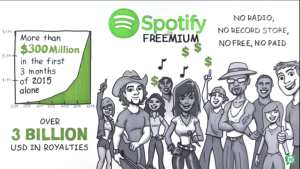 Seven months after Taylor Swift withdrew her music from Spotify, and two days after Apple announced its subscription-only Apple Music service, Spotify has released a video which firmly defends the freemium model which offers free, ad-supported listening. The video is part of an audience metrics update in which Spotify announced 75-million monthly users and 20-million subscribers. Spotify is, by far, the most successful music subscription service, and the video seeks to explain why free-listening is an essential ingredient in that success.
Seven months after Taylor Swift withdrew her music from Spotify, and two days after Apple announced its subscription-only Apple Music service, Spotify has released a video which firmly defends the freemium model which offers free, ad-supported listening. The video is part of an audience metrics update in which Spotify announced 75-million monthly users and 20-million subscribers. Spotify is, by far, the most successful music subscription service, and the video seeks to explain why free-listening is an essential ingredient in that success.
In the video, Spotify provides some metrics support for the argument that free listening funnels users into the paid subscription plan, which is where record labels want users to be. The video is also remarkable as being the company’s most explicit and public-facing advocacy of free listening, upholding the very concept of free as essential to music industry health in all eras. (See the video below.)
The word “free” has been kindling for flaming arguments in the music industry for over 15 years. When the original Napster file-sharing service became popular (to put it mildly when referring to that hyper-viral downloading platform), one music industry battle cry was, “You can’t compete with free.” Spotify is saying that “free” is not only helpful, but essential in the digital era when an emerging generation of music lovers has little concept of music as a pay-per-unit product.
“There’s a lot of static out there about free music,” the video’s narration begins. “It’s time to set the record straight.” The script then reviews the historical role of radio (free listening) as a catalyst of music purchasing — while poking at radio for “annoying ads and songs you didn’t like,” explicit user criticisms we are accustomed to hearing from Pandora, but not from Spotify. With download piracy, the video continues, “stolen music led to record losses” of industry revenue.
In putting a historical sweep in its defense of free listening, Spotify really champions the combination of freemium and subscription, claiming that either one alone doesn’t work powerfully to deliver industry revenue. “Spotify bridged the gap with freemium, our two-tiered business model.” To support that claim of providing an essential bridge across generations, Spotify notes an interesting metric: 80% of subscribers started as free listeners. “Freemium works,” the video declares. (We asked Spotify whether the 80% statistic includes trial periods that rolled into paid subscriptions.
Musicians (like Taylor Swift) who are uneasy with Spotify Freemium might argue that it provides too much interactivity, removing motivation to upgrade. Spotify says the plans includes “major limits on the user experience” — namely, automatic song shuffling, commercials, and no offline listening. In another alignment with typical Pandora rhetoric, Spotify calls its freemium plan “custom radio.” In so doing, it is downplaying the interactive features, which far exceed the user controls in Pandora’s non-interactive service.
As for the subscription level, Spotify calls it “A music store in your pocket.” Spotify’s proposed value chain is clear: Freemium replaces radio as the driver of music spending for consumers who are alienated from the legacy model of radio and records.
Spotify generously does not mention that broadcast radio is exempt from paying artists and labels, but it could have. Instead, it updates royalty payout numbers: $3-billion overall, and $300-million in the first quarter of this year.
“Without the static, your choice is clear,” the video concludes. Here is the video:

Spotify DOES NOT pay the artists any where near enough !
We have a lot of music on the internet.
cdBaby, iTunes, amazon all pay well.
Typical Spotify payment to Dynamic Recording:
63 streams – $.06 cents. This is a major rip off.
And Sound Exchange is worse !
Radio does pay artists. They pay a broadcasting fee and a collection agency like APRA in New Zealand distributes the royalties.